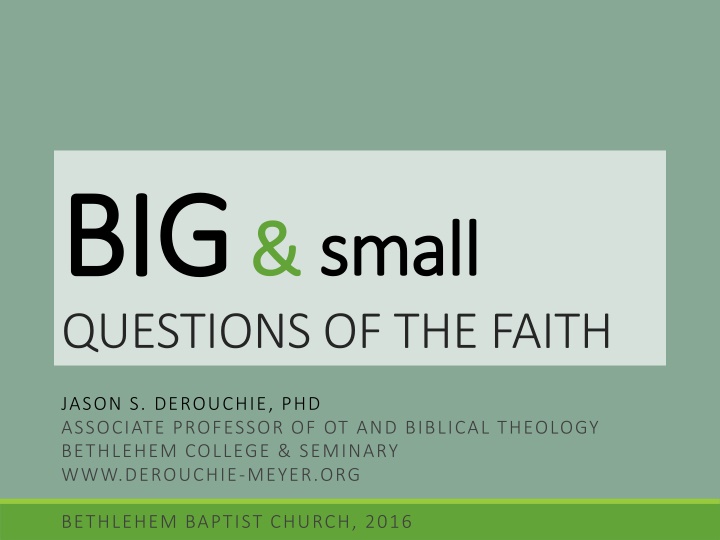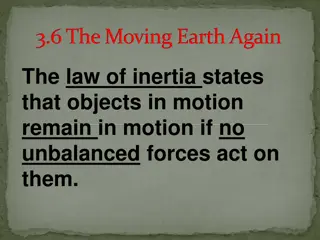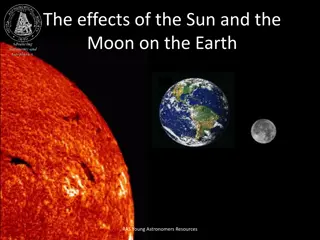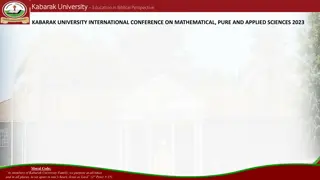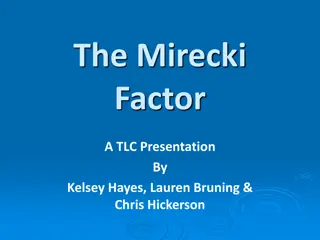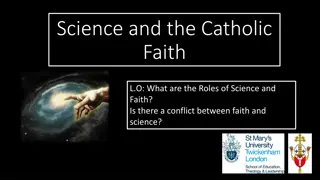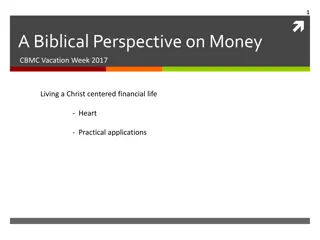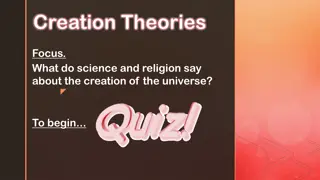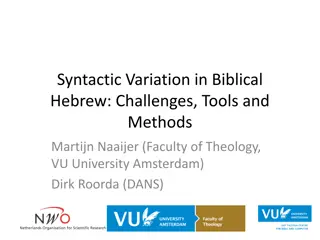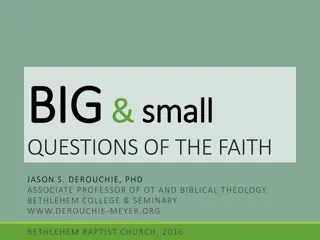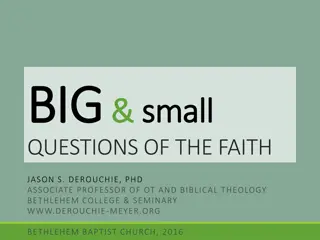Exploring Young Earth Creationism: A Biblical Perspective
Delve into the Young Earth Creationist viewpoint through the lens of biblical theology as presented by Dr. Jason S. Derouchie. Discover the rationale behind the belief in a mature earth created by God in six literal 24-hour periods, and explore the interpretation of the Creation Week as outlined in Genesis 1. Gain insight into the argument for a young earth being 6,000 to 10,000 years old and the alignment of this perspective with the Sabbath pattern in the biblical narrative.
Download Presentation

Please find below an Image/Link to download the presentation.
The content on the website is provided AS IS for your information and personal use only. It may not be sold, licensed, or shared on other websites without obtaining consent from the author.If you encounter any issues during the download, it is possible that the publisher has removed the file from their server.
You are allowed to download the files provided on this website for personal or commercial use, subject to the condition that they are used lawfully. All files are the property of their respective owners.
The content on the website is provided AS IS for your information and personal use only. It may not be sold, licensed, or shared on other websites without obtaining consent from the author.
E N D
Presentation Transcript
BIG BIG& &small QUESTIONS OF THE FAITH small JASON S. DEROUCHIE, PHD ASSOCIATE PROFESSOR OF OT AND BIBLICAL THEOLOGY BETHLEHEM COLLEGE & SEMINARY WWW.DEROUCHIE-MEYER.ORG BETHLEHEM BAPTIST CHURCH, 2016
QUESTION Why do you hold to YEC, believing that God created a mature earth in in six 24-hour periods in a literal week and that the earth is extremely young 6,000 10,000 earth-years old?
My 24 My 24- -Hour Mature, Young Hour Mature, Young- - Earth View Earth View Roughly six ten thousand earth years ago God created the universe and all life in six successive natural days marked by evenings and mornings in the pattern set- forth in Genesis 1.
The Creation Week The Creation Week Days 1 3 = The Formless Takes Shape o Day 1 (vv. 2 5): God creates light God separates light and dark/day and night o Day 2 (vv. 6 8): God creates the expanse ( heavens in 1:8 = the earth s atmosphere + outer space as part of the heavens in 1:1) God separates waters above and below o Day 3 (vv. 9 13): Creation of land and vegetation God separates land and seas
Days 46: The Void Becomes Filled o Day 4 (vv. 14 19): God creates luminaries for the heavens (2 greater lights and the stars) God places and delegates luminaries for signs and to rule over day and night, to separate light from darkness and day from night, and to distinguish seasons, days, years. o Day 5 (vv. 20 23) God creates air and sea creatures God delegates them to be fruitful, to multiply, and to fill the seas and land. o Day 6 (vv. 24 31) God creates land creatures and mankind God delegates land creatures to fill the land and mankind to fill the land and rule over the creatures of the sea, sky, and land. Day 7: God s sovereign rest
Support for a 24 Support for a 24- -Hour Mature Earth View Earth View Hour Mature Day and week imagery in Genesis 1: o The one week structure (1:1 2:3) o The mention of light and darkness, day and night (1:5; cf. 14, 16, 18) o The use of day with the refrain there was evening and there was morning (Gen. 1:5, 8, 13, 19, 23, 31).
The Sabbath pattern: o Even before God reveals himself at Sinai, Israel s 6+1 Sabbath cycle is firmly set into her pattern of life (Exod 16:23 29; cf. 20:11; 31:17). o A solar day, a lunar month, and a solar year are set by the earth s daily rotation and its annual revolution around the sun. However, the structure of a seven day week has no astronomical connection. o We must ask, What made Israel keep this pattern?
o God calls Israel to keep the Sabbath cycle because his creation of the universe followed this structure. The seventh day is a Sabbath to the LORD your God. On it you shall not do any work . For in six days the LORD made heaven and earth, the sea, and all that is in them, and rested on the seventh day (Exod 20:10 11). o Treating the original week as figurative supplies no actual analogy, but if God indeed created in six days and rested on the seventh, Israel gained a solid pattern around which to base their lives.
The 24-hour mature earth view is the most natural reading of the text.
Potential Challenges Potential Challenges Can we really have day and night without the sun? o The proposed problem relates to the scientific doctrine of uniformitarianism. o The sun is not needed for day and night; what is needed is fixed light and a rotating earth. o In the new heavens and earth night will be no more and people will need no light of lamp or sun, for the Lord God will be their light (Rev 22:5).
o The way John opens his Gospel by echoing Genesis 1:1 and by stressing the living Word s nature as light and life suggests John saw the divine Son as the light that sustains creation; the sun becomes merely an agent. John 1:1 5. In the beginning was the Word, and the Word was with God, and the Word was God. He was in the beginning with God. All things were made through him, and without him was not any thing made that was made. In him was life, and the life was the light of men. The light shines in the darkness, and the darkness has not overcome it.
o Paul too identifies the light of Christ with the initial creation event. 2 Cor 4:6. For God, who said, Let light shine out of darkness, has shone in our hearts to give the light of the knowledge of the glory of God in the face of Jesus Christ. o Conclusion: Having day and night without the sun is not a problem, for the text portrays God as the sustainer and source of light. Within the creation account, light is never made ; it simply appears in the created sphere, which may point to light finding its source in God.
Couldnt day just mean an indefinite period of time? o The Hebrew yom ( day) can refer to: (1) Daylight (1:5) (2) A 24-hour period (1:5, 8, 13, 19, 23, 13) (3) An indefinite period (2:4). o There is little evidence for sense (3) in Gen 1:2 3. o Sense (3) does not explain evening and morning language.
Even if you have a seven day work-week presented, don t the literary features of the text suggest it is not a chronological, historical presentation? o I affirm the literary artistry of Gen 1:1 2:3: The repetitive narrative pattern: o And God said o And it was so o And God made o And God did o And God called o And God saw that it was good o And God blessed saying o And there was evening, and there was morning
Even if you have a seven day work-week presented, don t the literary features of the text suggest it is not a chronological, historical presentation? o I affirm the literary artistry of Gen 1:1 2:3: The repetitive narrative pattern The literary framework:
Even if you have a seven day work-week presented, don t the literary features of the text suggest it is not a chronological, historical presentation? o I affirm the literary artistry of Gen 1:1 2:3: The repetitive narrative pattern The literary framework The use of the article only at Day 6 in the day- ending formula: o A first day o A second day o A third day o A fourth day o A fifth day o The sixth day
Even if you have a seven day work-week presented, don t the literary features of the text suggest it is not a chronological, historical presentation? o I affirm the literary artistry of Gen 1:1 2:3: The repetitive narrative pattern The literary framework: The use of the article only at Day 6 in the day- ending formula Numerous patterns in multiples of seven o 7 days o God as explicit subject = 35x o Earth = 21x o Good = 7x o Heavens + expanse + separation = 21x
Even if you have a seven day work-week presented, don t the literary features of the text suggest it is not a chronological, historical presentation? o I affirm the literary artistry of Gen 1:1 2:3: The repetitive narrative pattern The literary framework The use of the article only at Day 6 in the day- ending formula Numerous patterns in multiples of seven A selective portrayal without a goal of describing everything
o Literary artistry does not mean a-historical: The exodus accounts in Exodus 14 15 The story of Deborah and Barak s defeat of Sisera in Judges 4 5 o Genesis 1:1 2:3 uses the normal narrative verb pattern in Hebrew. o The poetic elements set us up for apparent contradictions between Genesis 1 2.
What do you do with the chronological challenges between Genesis 1 2? o Challenge 1: Were animals created before or after mankind (Gen 1:24 27; 2:7, 19)? Response: o ESV: Now out of the ground the LORD God had formed every beast of the field. . . . o NASB: Out of the ground the LORD God formed every beast of the field. . . .
o Challenge 2: Were plants created on Day 3 or Day 6 (Gen 1:11 12; 2:5)? Gen 2:5 7. Now no shrub of the field was yet in the earth, and no plant of the field had yet sprouted, for the LORD God had not sent rain upon the earth, and there was no man to cultivate the ground. But a mist used to rise from the earth and water the whole surface of the ground. Then the LORD God formed man of dust from the ground, and breathed into his nostrils the breath of life; and man became a living being.
o Challenge 2: Were plants created on Day 3 or Day 6 (Gen 1:11 12; 2:5)? Gen 2:5 7. Now no shrub of the field was yet in the earth, and no plant of the field had yet sprouted, for the LORD God had not sent rain upon the earth, and there was no man to cultivate the ground. But a mist used to rise from the earth and water the whole surface of the ground. Then the LORD God formed man of dust from the ground, and breathed into his nostrils the breath of life; and man became a living being. Response Summary: Gen 2:5 mentions a new kind of plant that God had not yet created and clarifies that the normal conditions you and I expect in this post-fall world had not yet appeared.
Gen 1:1112 states that God brought forth two kinds of vegetation: o (1) Small plants yielding seed = Whole grain plants like barley, corn, kamut, rice, rye berries, sorghum, spelt, and wheat berries o (2) Fruit trees = Trees bearing fruit While 2:9 tells us there was every tree that is pleasant to the sight and good for food, Gen 2:5 states that two realities had not yet happened because these demanded rain and cultivation: o (1) No bush of the field = uncultivated shrubs found in remote wilderness regions (see Gen 21:15; Job 30:4, 7; cf. thorns and thistles, 3:18) o (2) The small plants (yielding seed) had not yet sprouted (NIV) grain
Genesis 2 distinguishes the garden from the field. o God created man from the ground and placed man into the garden (2:7). o God brought man in the garden every beast of the field to name (2:19). o God s curse against humanity meant: (1) That the earth would bring forth thorns and thistles for mankind and that he would now eat the plants of the field (3:18; cf. 2:5). (2) That mankind would now be kicked out of the garden to work the ground (3:23; cf. 2:5) For the reader living in the post-fall world, Genesis 2:5 is signaling that the curse had yet to come, that the normal world as we know it had yet to begin, and that God anticipated the fall to happen quickly.
Could so much have really happened on Day 6? o Day 6 includes all that happens in Gen 1:26 30 and 2:4 25: God creates animals; God creates the man; God tells the man the parameters for life; Man names all the animals; God creates the woman. The man and woman get married. o Question: How can all this happen in a single day?
o Note 1: According to their kinds need not correspond to our modern categorization of species, so Gen 2:19 20 need only mean Adam named broad categories of animals. o Note 2: I offer this proposal, adapted from my friend Joe Rigney, who is also a YEC:
How Could Day 6 Played Out? How Could Day 6 Played Out? 6:00 AM God makes the animals (Gen 1:24 25) 6:01 AM God takes counsel with himself to make man (Gen 1:26) 6:02 AM God makes Adam from the dust of the ground (Gen 2:7) 6:05 AM God starts to plant the Garden (Gen 2:8 9) 6:10 AM The Garden is complete 6:11 AM God puts Adam in the Garden (Gen 2:15) 6:12 AM God warns Adam about the forbidden tree (Gen 2:16 17)
How Could Day 6 Played Out? How Could Day 6 Played Out? 6:13 AM Adam has breakfast 6:30 AM God reveals plans for a helper (Gen 2:18) 6:31 AM God brings the animals to Adam to name (Gen 2:19 20) 3:00 PM Adam takes a nap (Gen 2:21) 3:25 PM Adam wakes up, meets Eve, and the two get married (Gen 2:22 23) 3:29 PM God blesses Adam and Eve with a commission (Gen 1:28 30) 3:30 PM Two hours until sunset to be naked and unashamed (Gen 2:25) What s so hard about that?
Day 7 identifies the week as heavenly, not earthly, time, and it never ends, so we shouldn t consider Gen 1:1 2:3 as detailing earthly time? o Overview: The evening and morning pattern is lost in Day 7, suggesting it never ended. We already know that heavenly time is not the same as ours (Ps 90:4; 2 Pet 3:8). Hebrews 4:4 11 also suggests the day never ended: For he has somewhere spoken of the seventh day in this way: God rested on the seventh day from all his works. . . . It remains for some to enter it. . . . So then, there remains a Sabbath rest for the people of God, for whoever has entered God s rest has also rested from his works as God did from hi. Let us therefore strive to enter that rest.
o Response: The pattern of the workweek was over, so there was no reason to include the transition formula at the end of Day 7. John 5:17 states that both the Father and Son were working in the days of Christ, which suggests the original week came to an end.
